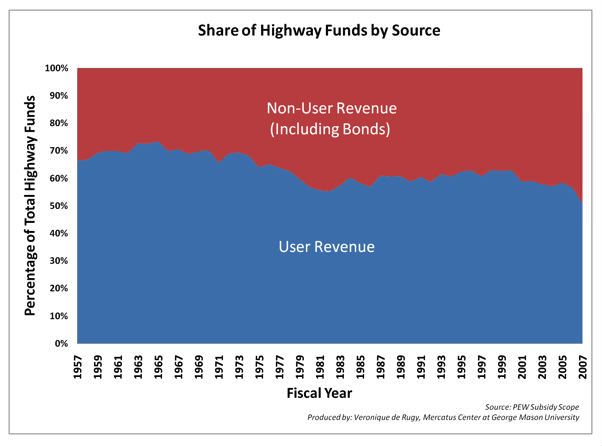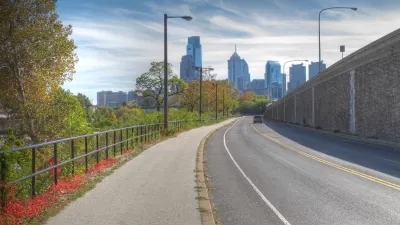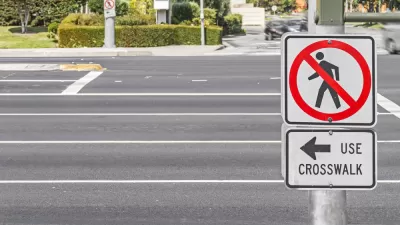An important current policy debate concerns whether the next U.S. federal surface transportation reauthorization should require spending on “enhancements,” which finance projects such as walkways, bike paths, highway landscaping and historic preservation. This issue receives considerable attention, despite the fact that enhancements represent less than 2% of total federal surface transportation expenditures, because it raises questions about future transport priorities, particularly the role of walking and cycling. In other words, should non-motorized modes be considered real transportation.
An important current policy debate concerns whether the next U.S. federal
surface transportation reauthorization should require spending on
"enhancements," which finance projects such as walkways, bike paths, highway landscaping and historic preservation. This issue
receives considerable attention, despite the fact that enhancements represent less
than 2% of total federal surface transportation expenditures, because it raises
questions about future transport priorities, particularly the role of walking and cycling. In other words, should non-motorized modes be considered real transportation.
Critics argue that enhancements projects are luxuries and it is unfair to divert
motor vehicle user fees to projects that do not directly benefit motorists. As Ronald Utt of the Reason Foundation wrote about enhancement funding categories, "Alert
readers will note that none of the above eligible uses supports transportation
in the modern sense of the term. Indeed, these 12 categories have as much to do
with transportation and mobility as G.I. Joe dolls have to do with national
security." According to that view, walking and cycling are not real transportation, at least, not in the "modern sense of the term," they are nothing more than children's entertainment. (I wonder if this perspective is shared by Reason Foundation fellow and
Planetizen Blogger, Samuel Staley, who recently described how he enjoys bicycle commuting. Any comments
Sam?) Let's examine these arguments.
Responsive Priorities
As described in a previous Column, travel demands are
changing. Total motor vehicle travel peaked in 2007 and is expected to remain
flat in most area (those not experiencing rapid population growth) due
to demographic and economic trends including aging population, rising
fuel prices, increasing health and environmental concerns, and changing
consumer preferences. This is not to suggest that North Americans will give up
driving altogether, but at the margin many people want to drive less and rely
more on alternatives, provided they are convenient, comfortable and
integrated. It makes sense for transport policies to respond to these demands by helping create a more diverse, resource-efficient transport
system.
Although federal funds provide only about 30%
total roadway expenditures, they have significant leverage effects on state
and local transport planning decisions. For example, if the federal government
offers attractive grants for highway projects, states and local
governments will plan to solve their transport problems with highway expansions. If more federal funding is provided for alternative modes, state and local officials will consider other
solutions.
Current planning tends to be biased in various, often subtle ways
that favor automobile transport over other modes. For example, conventional
travel surveys, and resulting travel statistics, tend to undercount
non-motorized travel because they overlook short trips, off-peak trips, travel
by children, and non-motorized links of linked trips. A bike-transit-walk trip
is often coded simply as a transit trip, and a motorist who parks several
blocks from work and walks is simply considered an auto commuter. Although
conventional travel surveys suggest that only 4-6% of trips are non-motorized,
more comprehensive surveys, such as the National
Household Travel Survey, indicate they are actually 10-15%, and even higher in large
cities. Non-motorized travel improvements receive far less than this portion of
funding: only
1.2% of total federal surface transport funds are spent on non-motorized
facilities, and although local governments probably devote a somewhat larger share of their transport budgets to sidewalks and paths, perhaps 3-6%, but that is still much less than the share of non-motorized trips.
Another bias is that transport system performance is
generally evaluated using mobility-oriented indicators, such as roadway
level-of-service, average traffic speed, and traffic congestion delays, which
assumes that the goal is to maximize vehicle travel speeds, so faster modes are
more important than slower modes. This approach tends to undervalue
non-motorized modes, and ignores the ways that planning decisions that improve
motorized travel often reduce non-motorized accessibility, for example, if
wider roads and increased travel speeds create a barrier to walking and
cycling, and if highway expansion and generous minimum parking requirements encourages
dispersed, automobile-oriented development that reduces land use accessibility.
For example, this type of planning considers the transport
system to fail if motorists encounter congestion (roadway level-of-serve D or
worse) when chauffeuring children to school, or driving to a gym to exercise on
a treadmill, or somebody drives to reach a recreational cycling path, but does not
recognize a failure if inadequate walking and cycling facilities prevent
students from walking and cycling to schools, or if residents are unable to walking or bicycle in their own neighborhoods. Fortunately, the new Highway Capacity Manual
includes guidance on multi-modal
level-of-service evaluation, but such reforms are inadequate without funding to improve walking and cycling conditions.
Most federal and state funds are dedicated to roads. About half of all states have constitutional amendments that dedicate road user fees to highways. Federal match rates tend to be higher for highways than for other modes, and highway projects often require less analysis and review than other transport investments.
Critics argue that non-motorized improvements, if justified,
are a local rather than a federal concern, but this ignores the large portion
of federal highway capacity used for local travel. As a result, the federal government helps accommodate
motorists driving children to school, driving to gyms or trails for exercise,
and numerous other local trips, some of which could instead be made by walking and
cycling if conditions were better.
Non-motorized Transport Benefits
Improved walking and cycling conditions, and increased
non-motorized travel activity can provide numerous benefits to users and
society, including congestion reductions, road and parking facility cost savings,
consumer savings and affordability, improved mobility for non-drivers, energy
conservation, pollution emission reductions, improved public fitness and health,
and local economic development. Total per capita accident rates (including both motorized and non-motorized road users) tend to decline as walking and cycling
rates increase in a community, an effect called safety in
numbers.
Even motorists who never walk or bicycle can benefit from such improvements. For
example, if you want your neighbor to avoid driving home after drinking at the
local bar, it's pretty important that he have good sidewalks. Improving walking
and cycling conditions reduces drivers' chauffeuring burdens.
Critics sometimes argue that only a small portion of travel
can reasonably shift to walking and cycling, or non-motorized improvements do
little to reduce problems such as traffic and parking congestion, but this
reflects an incomplete understanding of the role walking and cycling play in an
efficient transport system. Communities with good non-motorized facilities have
walking and cycling mode shares several times higher than the North American
average. Many of these additional non-motorized trips substitute for driving.
Improving walkability increases the parking facilities that serve a
destination, reducing parking congestion problems. Most public transit trips
include non-motorized links, and improving walking and cycling conditions is
often key to shifting travel from driving to public transit. A shorter
pedestrian or bicycle trip often substitutes for a longer motorized trip,
non-motorized travel improvements support more compact land use development,
and improving alternative modes allows some households to reduce their vehicle
ownership, so pedestrian and cycling improvements can leverage additional reductions
in automobile travel, so each mile increase in pedestrian and cycling travel
can provide more than vehicle-mile reduction in automobile travel.
Funding Equity
Enhancement critics argue that it is unfair to spend money
collected from motorists though fuel taxes and other user fees to finance other
modes, based on the assumption that consumers should "get what they
pay for and pay for what they get."
But this argument is hypocritical since the same logic also
demands that motorists should bear the full costs they impose. In fact, road user
fees finance less than half of total roadway expenditures, a portion that is
declining since fuel taxes have not increased to account for inflation. Walking and bicycling impose far lower (probably about 10%) road and parking costs than driving measured per mile, and non-drivers tend to travel far fewer annual miles than motorist on average. As a
result, people who rely primarily on walking and cycling for transport tend to subsidize the transport
costs of their neighbors who drive.

Total roadway expenditures per capita average about $400 annual per capita, about half from motorist user fees and half from general taxes. This is the amount an average traveler imposes and pays. A person who relies primarily on non-motorized travel pays $200 annually in general taxes but only imposes about $25 in roadway costs, and so pay $175 more than their costs. Conversely, a motorist who drives twice average mileage imposes $800 in roadway costs but only pays $600 in taxes, and so underpays.
Vehicle travel imposes other external
costs. There are typically three or
more off-street parking spaces provided per motor vehicle, with total value estimated at $1,000-2,000 annual per vehicle, and motor vehicle travel imposes significant accident and pollution costs on other road users, including pedestrians and cyclists. As a result, higher-annual-mileage motorists significantly underpay, and people who rely on alternative modes overpay their transport costs. This is unfair and economcially inefficient because it encourages people to drive more than they would choose if road users paid directly for the costs they impose.
Enhancements help mitigate the risks and problems that motor
vehicle travel imposes, for example by financing
pedestrian bridges over highways that divide neighborhoods, and paths that
separate pedestrians and cyclists from highway risk and pollution. In
other words, enhancements allow motorists to help clean up the mess they make.
As I've written
previously, automobile transportation is so costly that it tends to make users selfish. In an automobile
dependent community people are forced to drive even if it strains their budget.
They then argue, "I'm forced to spend thousands of dollars annually on a car just for
basic transportation, I can't possibly afford to pay more. I need a subsidy!" As a result, they become
upset when asked to pay the full costs of roads, parking and fuel, or to share resources with other modes. The smart solution to this problem is to improve alternatives so people have better, more affordable options.
That is exactly the value of Enhancements.
What do you think? Should federal support for non-motorized modes increase or decline in the future? What arguements do you find most persuasive in this debate?
For More Information
ABW (2010), Bicycling
and Walking in the U.S.: 2010 Benchmarking Report, Alliance for Biking
& Walking (www.peoplepoweredmovement.org);
at www.peoplepoweredmovement.org/site/index.php/site/memberservices/C529.
Joe Cortright (2009),
Walking the Walk: How Walkability Raises
Home Values in U.S. Cities, CEOs for Cities (www.ceosforcities.org); at www.ceosforcities.org/files/WalkingTheWalk_CEOsforCities1.pdf.
FIA – UNEP (2011), Share the Road: Investment in Walking
and Cycling Road Infrastructure,
FIA Foundation for Automobiles and Society and the United Nations Environmental
Program (http://www.unep.org); at http://www.unep.org/transport/sharetheroad/PDF/SharetheRoadReportweb.pdf.
Fietsberaad (2009), Cycling in
the Netherlands, Ministry of Transport, Public Works and Water Management (www.minvenw.nl) and Fietsberaad (Expertise Centre for Cycling
Policy) (www.bicyclecouncil.org); at www.fietsberaad.nl/library/repository/bestanden/CyclingintheNetherlands2009.pdf.
LAB (2010), Highlights
the 2009 National Household Travel Survey, League of American Bicyclists (www.bikeleague.org);
at www.bikeleague.org/resources/reports/pdfs/nhts09.pdf.
Todd Litman (2003), "Economic Value of Walkability," Transportation
Research Record 1828, Transportation Research Board (www.trb.org), pp. 3-11; at www.vtpi.org/walkability.pdf.
Todd Litman (2005), Whose Roads? Evaluating Bicyclists' and
Pedestrians' Right to Use Public Roadways, VTPI (www.vtpi.org); at www.vtpi.org/whoserd.pdf.
Todd Litman (2010), Short
and Sweet: Analysis of Shorter Trips Using National Personal Travel Survey Data,
VTPI (www.vtpi.org); at www.vtpi.org/short_sweet.pdf.
Todd Litman (2011), Evaluating
Non-Motorized Transport Benefits and Costs, Victoria Transport Policy
Institute (www.vtpi.org); at www.vtpi.org/nmt-tdm.pdf; originally
published as "Quantifying Bicycling Benefits for Achieving TDM Objectives," Transportation Research Record 1441,
Transportation Research Board (www.trb.org),
1994, pp. 134-140.
Living Streets (2011), Making
The Case For Investment In The Walking Environment, Living Streets Program
(www.livingstreets.org.uk),
University of the West of England and Cavill Associates; at www.livingstreets.org.uk/index.php/tools/required/files/download?fID=1668.
NHTS (2010), Active
Travel: NHTS Brief, National Household Travel Survey (http://nhts.ornl.gov); at http://nhts.ornl.gov/briefs/ActiveTravel.pdf.
S. Turner, R. Singh,
P. Quinn and T. Allatt (2011), Benefits Of New And Improved Pedestrian
Facilities – Before And After Studies, Research Report 436, NZ Transport
Agency (www.nzta.govt.nz); at www.nzta.govt.nz/resources/research/reports/436/docs/436.pdf.

Alabama: Trump Terminates Settlements for Black Communities Harmed By Raw Sewage
Trump deemed the landmark civil rights agreement “illegal DEI and environmental justice policy.”

Planetizen Federal Action Tracker
A weekly monitor of how Trump’s orders and actions are impacting planners and planning in America.

Why Should We Subsidize Public Transportation?
Many public transit agencies face financial stress due to rising costs, declining fare revenue, and declining subsidies. Transit advocates must provide a strong business case for increasing public transit funding.

Understanding Road Diets
An explainer from Momentum highlights the advantages of reducing vehicle lanes in favor of more bike, transit, and pedestrian infrastructure.

New California Law Regulates Warehouse Pollution
A new law tightens building and emissions regulations for large distribution warehouses to mitigate air pollution and traffic in surrounding communities.

Phoenix Announces Opening Date for Light Rail Extension
The South Central extension will connect South Phoenix to downtown and other major hubs starting on June 7.
Urban Design for Planners 1: Software Tools
This six-course series explores essential urban design concepts using open source software and equips planners with the tools they need to participate fully in the urban design process.
Planning for Universal Design
Learn the tools for implementing Universal Design in planning regulations.
Caltrans
Smith Gee Studio
Institute for Housing and Urban Development Studies (IHS)
City of Grandview
Harvard GSD Executive Education
Toledo-Lucas County Plan Commissions
Salt Lake City
NYU Wagner Graduate School of Public Service






























